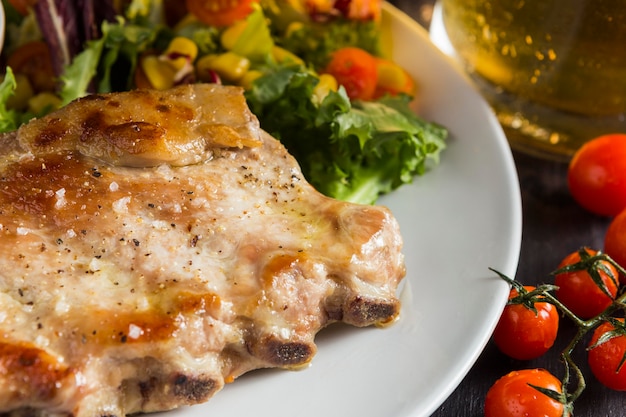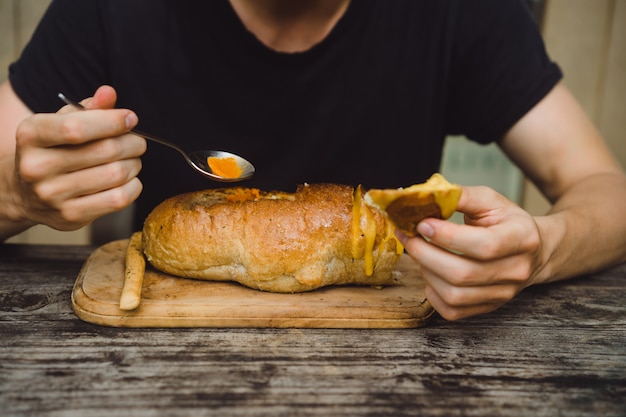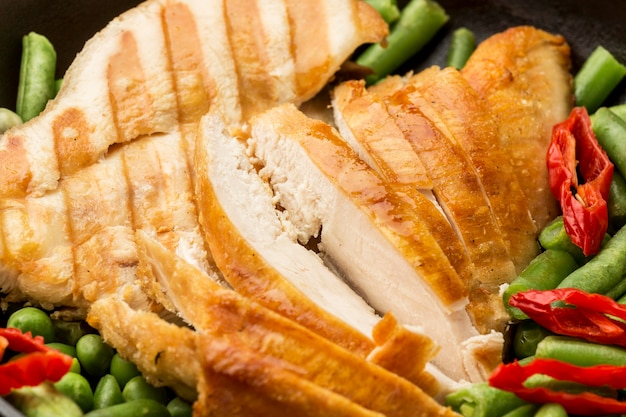Let's face it, roasting a turkey breast can be a bit daunting. There's the whole timing thing, and the fear of ending up with a dry, overcooked bird. But I'm here to tell you, it's not as complicated as it seems! I've been making this classic dish for years, and I'm happy to share my secrets for the perfect oven-roasted turkey breast, especially if you're working with a 3lb breast. It's a great size for a family dinner or a potluck, and it's surprisingly easy to get right.
Part 1: Picking the perfect turkey Breast

The first step, like with any great dish, is choosing the right ingredients. You've got options here, and picking the right one will make a big difference in the final outcome.
Bone-In or Boneless? A Tale of Two Birds
First things first, bone-in or boneless? This is a bit of a personal preference. I’m a huge fan of bone-in turkey breasts. They tend to be more flavorful, and the bone helps keep the meat moist during cooking. Plus, they're often a little more affordable. But let’s be real, boneless breasts are a real lifesaver when you're short on time. They're also incredibly convenient, and they cook a bit faster. If you go boneless, make sure it's thick and juicy – nobody wants a thin, dry piece of turkey!
Fresh or Frozen? The Time Factor
Next up, we have the fresh vs. frozen debate. I'm a fresh-turkey-breast kind of gal. There's something about the smell and texture of fresh meat that just gets me excited. However, we all have busy lives, and frozen turkey breasts are a lifesaver when you need a quick dinner solution. Just remember, if you're using frozen, you'll need to defrost it completely before cooking, or you'll end up with unevenly cooked meat.
Size Matters!
And finally, the size. A 3lb breast is perfect for a small family or a few hungry guests. It's not too big, but it's not too small either. However, if you're cooking for a larger crowd, you might want to consider a bigger breast or even a whole turkey.
Part 2: Getting Ready to Roast

Now that you've got your turkey breast, it's time to prep it for the oven. This might seem simple, but it truly makes a difference in the final result.
Prepping the Breast: It's All About the Rub
First, give your turkey breast a rinse under cold water and pat it dry with paper towels. Then, it's time for the fun part – giving it a good rub. I'm talking about a rub with herbs and spices, of course! There are endless possibilities here, but I'm partial to a blend of rosemary, thyme, sage, and garlic powder. It adds a wonderfully aromatic depth to the flavor. You can also add salt and pepper to taste. Don't be afraid to get creative! Experiment with different combinations and find your perfect blend.
Choosing the Right Pan: Space is Key
Next, you need to choose the right pan. A roasting pan is the classic choice, and it's definitely a good one. However, if you're working with a smaller breast, a baking dish might suffice. Just make sure your pan is big enough to accommodate the breast comfortably. You want it to have plenty of space to breathe and cook evenly.
Don't Forget the Butter! The Moisture Miracle
Finally, grab some butter. This is the secret weapon for a juicy, flavorful turkey breast. Rub it all over the breast, getting it into all the nooks and crannies. This helps to keep the meat moist and adds a delicious richness. If you're feeling fancy, you can also add some chopped herbs or garlic to the butter for an extra punch of flavor.
Part 3: The Big Roast

Okay, we’ve prepped our turkey breast, it's nestled in the roasting pan, and we're ready to get cooking!
Setting the Oven Temperature: Finding the Sweet Spot
Preheat your oven to 350°F (175°C). This temperature is a good starting point, but you might need to adjust it depending on your oven and the size of your breast. If your oven tends to run hot, you might want to start at 325°F (160°C) to avoid overcooking.
Cooking Time: A Rough Guide
Now, the big question: how long do you cook it? For a 3lb bone-in turkey breast, I usually aim for around 1 hour and 45 minutes. But remember, this is just a general guideline. You'll want to check the internal temperature to ensure it’s cooked through.
Temperature is Key: Trust the Thermometer
This is where a trusty meat thermometer comes in. It's the best way to ensure your turkey breast is cooked perfectly. Insert the thermometer into the thickest part of the breast, avoiding any bones. Your turkey breast is done when the internal temperature reaches 165°F (74°C).
Part 4: The Importance of Resting
You've got your beautifully roasted turkey breast out of the oven, and it looks incredible. But hold on! Don’t rush to carve it just yet. Let it rest for 15-20 minutes. This is crucial. It allows the juices to redistribute throughout the meat, resulting in a much juicier and more flavorful turkey breast.
Keep It Covered: The Secret to Staying Moist
While the turkey breast is resting, cover it loosely with aluminum foil. This helps to trap in the heat and keep the meat moist. It's like giving it a little hug to ensure it stays delicious!
Part 5: Carving Up the Feast
Finally, the moment of truth! Time to carve that beautiful turkey breast.
Using a Sharp Knife: A Crucial Step
To get the best results, grab a sharp carving knife. A dull knife will tear the meat, making for an unappetizing presentation. Plus, you don’t want to fight with the knife, which can make the whole experience a bit frustrating.
Start at the Thickest Part: Even Slices
Begin by carving slices from the thickest part of the breast, going against the grain. This will make for nice, even slices. If you’re slicing with the grain, you'll end up with stringy, chewy meat.
Save the Bones: The Essence of Flavor
Once you've sliced the breast, you can use the bones to make a delicious turkey stock. This is a great way to use up every part of the bird and maximize your meal. Just toss the bones into a pot with some water, vegetables, and herbs. Simmer for a few hours, and you'll have a flavorful stock that's perfect for soups, stews, or gravy.
Part 6: Serving Up the Delight
Now that your turkey breast is carved, it's time to serve it up!
Dress it Up: A Feast for the Senses
I like to serve my turkey breast with a simple gravy. You can make it from scratch using turkey stock and pan drippings, or you can use store-bought gravy. I also like to serve it with a side of mashed potatoes, stuffing, and cranberry sauce. It's all about creating a comforting and satisfying meal.
Don’t Forget the Leftovers! The Ultimate Meal Prep
And don't forget about the leftovers! Turkey breast is fantastic in sandwiches, salads, or even a simple turkey pot pie. It's a great way to stretch your meal and enjoy delicious turkey for days.
Part 7: Adjusting for Different Weights
We’ve been focusing on a 3lb turkey breast, but what about different sizes?
Table of Cooking Times: A Quick Reference Guide
| Weight (lbs) | Cooking Time (minutes) |
|---|---|
| 2 | 120-135 |
| 3 | 145-165 |
| 4 | 170-195 |
| 5 | 195-220 |
| 6 | 220-245 |
As you can see, the cooking time increases as the weight of the breast increases. This is because a larger breast needs more time to cook through thoroughly.
Boneless vs. Bone-in: The Time Difference
It's worth noting that boneless turkey breasts cook a bit faster than bone-in breasts. So, if you’re using a boneless breast, you may want to reduce the cooking time by about 15-20 minutes. Just keep an eye on the internal temperature to make sure it reaches 165°F (74°C).
Part 8: A Few Tips from My Kitchen
I've been cooking for years, and I've learned a thing or two about roasting a turkey breast. Here are a few of my favorite tips.
Don’t Overcrowd the Pan: Space for Even Cooking
Make sure your turkey breast has enough room to breathe in the pan. If the breast is crowded, it won't cook evenly. This can lead to a dry or unevenly cooked bird.
Basting is Key: Keeping it Moist
Basting your turkey breast during cooking will help to keep it moist and flavorful. To bast, simply spoon some of the pan drippings over the breast every 30 minutes or so. This helps to create a beautiful, golden-brown crust and keep the meat juicy.
Use a Thermometer: Essential for Safety
Don't rely solely on visual cues to determine if your turkey breast is cooked through. Always use a meat thermometer to ensure it reaches the safe internal temperature of 165°F (74°C). This is crucial for ensuring your turkey is safe to eat.
Rest, Rest, Rest: The Key to Juiciness
Let your turkey breast rest for at least 15-20 minutes after cooking. This is essential for ensuring a juicy and flavorful outcome. It allows the juices to redistribute and settle, leading to a more tender and flavorful turkey breast.
FAQs
I get it. cooking a turkey breast can feel a bit daunting, especially if you're new to the game. Here are some frequently asked questions to help ease your mind.
1. Can I add stuffing to the roasting pan?
You can certainly add stuffing to the roasting pan, but be careful not to overcrowd it. If you're using a 3lb breast, you may not have enough room for a large amount of stuffing. Make sure the stuffing is spread out evenly and not packed tightly, and check its temperature to ensure it reaches 165°F (74°C).
2. Can I cook a turkey breast on a lower temperature?
Yes, you can cook a turkey breast on a lower temperature. However, it will take longer. If you choose to cook at a lower temperature, it's especially important to check the internal temperature with a meat thermometer to ensure it’s cooked through.
3. Can I freeze a cooked turkey breast?
Yes, you can freeze a cooked turkey breast. Wrap it tightly in plastic wrap and aluminum foil, and freeze for up to 3 months. To thaw, place the breast in the refrigerator overnight.
4. What if my turkey breast is dry?
A dry turkey breast is usually a sign of overcooking. Next time, try cooking it at a slightly lower temperature, basting it more frequently, and letting it rest for longer.
5. How do I make a flavorful gravy?
To make a flavorful gravy, start with your pan drippings. Pour them into a saucepan and whisk in some flour. Then, gradually whisk in turkey stock or chicken broth until you achieve the desired consistency. Season with salt, pepper, and any herbs you like.
So there you have it! With these tips and tricks, you're well on your way to roasting a perfectly delicious turkey breast. Don’t be afraid to experiment, have fun, and enjoy the process. You’ll be surprised how easy it is to create a truly satisfying and flavorful dish!
Everyone is watching

Prime Rib Roast Cooking Time Chart: Per Pound Guide
Cooking TipsPrime rib roast. Just the name conjures images of lavish dinners, crackling fires, and hearty laughter. It’s ...

How Long to Bake Potatoes in the Oven (Perfect Every Time)
Cooking TipsBaked potatoes are a staple in my kitchen. They're incredibly versatile, delicious, and surprisingly easy to m...

Perfect Rice Every Time: The Ultimate Guide to Cooking Rice
Cooking TipsAs a self-proclaimed foodie, I've always been a bit obsessed with rice. It's the foundation of countless cuisi...

The Ultimate Guide to Cooking Asparagus: Tips, Techniques, and Recipes
Cooking TipsAsparagus. The mere mention of this spring delicacy conjures up images of vibrant green spears, crisp and burs...

Ultimate Guide to Cooking the Perfect Thanksgiving Turkey
Cooking TipsThanksgiving. Just the word conjures up images of overflowing tables laden with delicious food, the scent of r...
